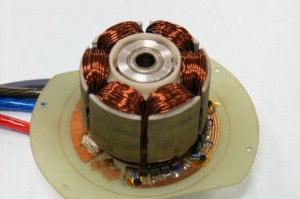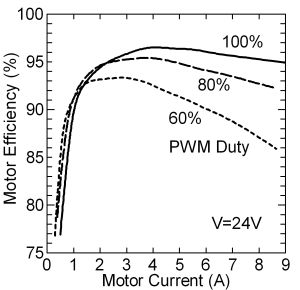Apr
6
Hideki Kimura, professor at the Department of Electrical and Electronic Engineering, School of Engineering at Tokai University announced his research group has developed a brushless DC motor that coverts electric power to motor output at a conversion efficiency of more than 96%.
The announcement was made last week during the 56th Spring Meeting of the Japan Society of Applied Physics at the University of Tsukuba in Japan.
Mr. Kimura said, “The idea to improve the efficiency can be applied to high-output motors for electric vehicles.” Judging from its output and speed, this motor has a wide range of applications, including refrigerators, electric bicycles and electric motorbikes.
In addition to its high maximum efficiency another notable feature of the motor is its capability to maintain conversion efficiency in the range from 93% to 96% even as the output changes between 50 watts and 200 watts.
Kimura’s group built the high efficiency motor by tracking down the causes of energy loss and making some improvements to reduce the loss. Motor energy loss is attributable to power consumption of the control circuit i.e. controller loss, loss from the coil winding i.e. the resistance, loss due to current surge in the iron core and loss from rotation axis friction and air resistance i.e. the bearing drag and windage loss from churning the air.
Achieving the 96+% efficiency came from a controller using a microcomputer with only a 156mW draw with an inverter built using nMOSFETS instead of using pMOSFETS. For gains in reducing resistance loss the group optimizing the thickness of the coil winding and the winding number. Mr. Kimura points out the optimization significantly contributes to the improvement as resistance generally increases as the current supplied to the motor becomes larger.
Bearing choices were optimized and windage is controlled with a cover.
Using iron-based amorphous metal as the core material reduces the core surge problem. This is because amorphous metal has low electron mobility, resulting in less current surge. The same material was used in a motor developed in 2003 at Tokai University with a conversion efficiency of 93%. It was commercialized by the University, Tokushu Denso Co Ltd and Nippon Kemikon Co Ltd. The technology is there.
The problem is the high production cost from the iron-based amorphous core material. Mr. Kimura says, “The iron-based amorphous core is produced by rapidly quenching the metal by spraying it on a low-temperature drum, but one round of quenching can only form a thickness of 25μm. Therefore, it has to be repeated to attain the necessary thickness, resulting in the high cost.” That would need a lot of repeats to get motor sized scale. The cost is nearly 20 times higher than that of commonly-used motors with efficiencies ranging from 80 to 89%. But Kimura offers the cost may be reduced to 1/4 or 1/5 if the production process is automated for mass production because the iron material itself is not expensive.
Applications are currently limited to products that require a high efficiency regardless of the high cost, such as eco cars for racing. In fact, an eco car equipped with the product developed in 2003 once won a race. Kimura says, “(The output can be further improved) simply by increasing the size of the motor, and if the output is improved, it will be even easier to enhance the efficiency.”
Its pretty interesting to see electric drive conversion getting to better than 96%. Innovation has a way of closing gaps and the gap is getting small with 3.5% all that’s left to go. The good motors of today at say 85% bumped to 96% is an eleven percent gain. What’s saved is mostly lost heat.
What matters is demand, getting the production of the iron-based amorphous core material driven to as cheap as possible. Yet we’re looking at the Japanese, who if anyone can, will drive to a lower cost, smaller and lighter motor. The replacement market could be huge, too. Going from an 80% to 96% efficiency is a 20% improvement, which if engineered correctly would directly translate into electricity rate savings.
The earlier motor design is in the Japanese market now. One can hope that rest of the world will have this technology on offer soon.
Comments
8 Comments so far




thx for the helpful post ye clever admin
Do you know what specific manufacturer produces such motors? Thank you!:)
pump motor for solar panels, mass product/million
[…] pretty good as they are now. 175 MPH Student-Designed Electric Car Shatters Land Speed Record! Japanese Researchers Breakthrough 96% Electric Motor Effiency Not sure how much better you expect things to get before you call them good. Behind this mask, […]
Now we nuke you
Where can I buy one of these?
Check the links and inquire with them.
what is te motor’s outside diameter and axial length?